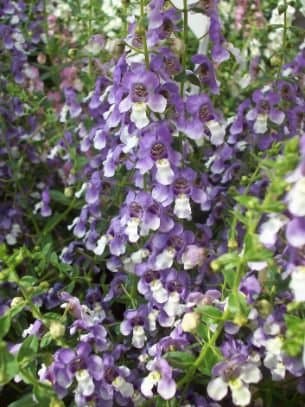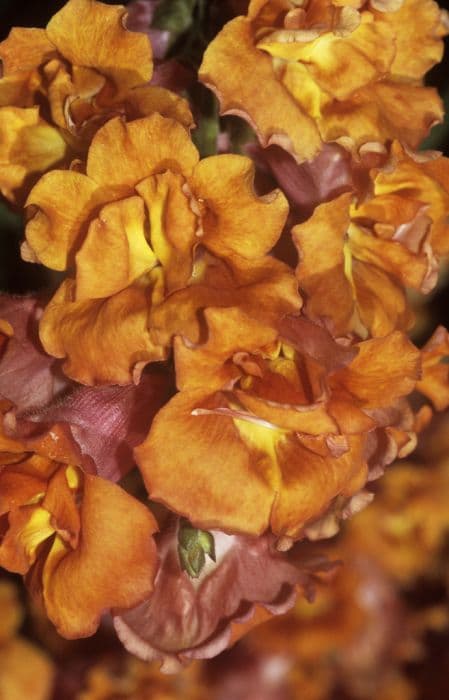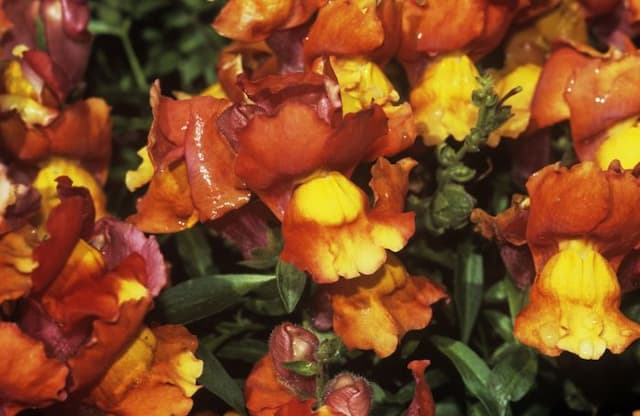Foxglove Digitalis × fulva

ABOUT
Digitalis × fulva, commonly known as rusty foxglove, presents a striking appearance typical of the foxglove family. It is characterized by its beautiful spike-like clusters of tubular flowers that display a warm, rusty orange hue, hence the name. Each flower is delicately spotted inside, which adds to its ornate look. These flowers gracefully hang from one side of the stem, forming an elegant droop. The foliage of rusty foxglove is comprised of simple, oval to oblong leaves that are arranged in a basal rosette at the base of the stem and alternately along the stem as well. These leaves are typically a lush green color, and they have finely toothed margins, which gives them a somewhat textured look. The overall form of the plant is upright and stately, contributing an air of stateliness to the gardens where they are commonly planted. The combination of the distinctive orange-hued flowers against the backdrop of green foliage makes rusty foxglove a favorite for adding visual interest to a landscape.
About this plant
 Names
NamesFamily
Plantaginaceae
Synonyms
Rusty Foxglove
Common names
Digitalis × fulva.
 Toxicity
ToxicityTo humans
Foxglove (Digitalis × fulva) is known for its toxicity due to cardiac glycosides, particularly digoxin and digitoxin. When ingested by humans, these toxins can cause a range of symptoms that affect the heart. These symptoms may include nausea, vomiting, diarrhea, headaches, dizziness, and confusion. In severe cases, there can be abnormal heart rhythms, which can lead to cardiac arrest and possibly death. The seriousness of the symptoms depends on the amount ingested, and medical attention should be sought immediately in the event of suspected foxglove poisoning.
To pets
Foxglove (Digitalis × fulva) is also highly toxic to pets due to the presence of cardiac glycosides. If a pet ingests part of the foxglove plant, it can experience symptoms such as vomiting, drooling, abdominal pain, diarrhea, and potentially lethal heart arrhythmias. The severity can range from mild to life-threatening depending on the dose ingested. All parts of the plant are toxic, and immediate veterinary care is essential if ingestion is suspected to prevent fatal consequences.
 Characteristics
CharacteristicsLife cycle
Biennials
Foliage type
Deciduous
Color of leaves
Green
Flower color
Orange
Height
2-3 feet (0.6-0.9 meters)
Spread
1-2 feet (0.3-0.6 meters)
Plant type
Herb
Hardiness zones
5
Native area
Varies
Benefits
 General Benefits
General Benefits- Attracts Pollinators: Digitalis × fulva is known to attract bees, butterflies, and other beneficial insects, aiding in pollination of gardens and ecosystems.
- Garden Aesthetics: With its tall, showy spikes of flowers, it can add height and visual interest to garden beds and borders.
- Habitat Creation: Provides shelter and food for wildlife, particularly insects, which use the plant for nectar and as a host plant for their larvae.
- Soil Stabilization: The root systems can help to prevent soil erosion in certain settings by anchoring the soil.
 Medical Properties
Medical Properties- Cardiac glycoside content: The Digitalis genus, known for "Foxglove", contains cardiac glycosides that can improve heart contractility.
- Heart failure treatment: Compounds derived from Digitalis have been historically used to treat certain heart conditions, such as heart failure and atrial fibrillation, by affecting the heart's pumping strength and rhythm.
 Air-purifying Qualities
Air-purifying QualitiesThis plant is not specifically known for air purifying qualities.
 Other Uses
Other Uses- Foxglove (Digitalis × fulva) can be used as a dye plant, imparting colors to fabrics due to the presence of various pigments in the leaves and flowers.
- The plant can serve as a muse for artists and photographers due to its striking flowers and tall, dramatic spikes.
- Foxglove is useful in garden design for adding vertical interest and can be planted to create a backdrop for lower-growing plants in garden beds.
- Its presence in a garden can encourage biodiversity, serving as a habitat and food source for bees, butterflies, and other insects.
- Used in education, foxglove can help teach children and students about plant biology and the ecological importance of pollinators.
- Foxglove leaves can be composted to return nutrients to the soil; however, caution should be exercised due to their potential toxicity.
- The dried flowers can be used in potpourri for a natural, subtle scent in the home.
- It's a candidate for natural pest control, as the toxicity of the plant may deter certain pests from the garden.
- Foxglove can be featured in folklore and storytelling to add a touch of mystery and historical references to gardens and landscapes.
- In survival situations, knowledge of foxglove's toxicity can be crucial, serving as an educational example of plants to avoid for consumption.
Interesting Facts
 Feng Shui
Feng ShuiFoxglove is not used in Feng Shui practice.
 Zodiac Sign Compitability
Zodiac Sign CompitabilityFoxglove is not used in astrology practice.
 Plant Symbolism
Plant Symbolism- Healing: Digitalis, commonly known as Foxglove, produces compounds used in heart medications, symbolizing its ability to heal and strengthen the heart.
- Bewitchment: With its stunning and vivid flowers, Foxglove symbolizes allure and enchantment, tying in with folklore where it's considered both magical and poisonous.
- Warning: Foxglove is poisonous if ingested, so it symbolizes caution and the need to be careful in certain situations.
- Insincerity: In the Victorian language of flowers, Foxglove could denote insincerity or a false sense of security due to its toxic nature, despite its beautiful appearance.
 Water
WaterThe Foxglove (Digitalis × fulva) should be watered deeply and thoroughly to ensure that the water reaches the roots, about once a week during the growing season. If the weather is especially hot or dry, increase the frequency of watering to every 3-4 days. Be careful not to over-water, as Foxgloves do not like to sit in waterlogged soil. Depending on the size of the plant, you might use 1-2 gallons of water each time you water to ensure the soil is moist but not soggy. In the dormant season, reduce watering to every couple of weeks, just enough to prevent the soil from completely drying out.
 Light
LightThe Foxglove thrives best in partial sunlight to light shade. Ideally, it should be planted in a spot that receives morning sunlight and is protected from the intense afternoon sun. Dappled light is also suitable for this plant, mimicking the conditions of its native woodland habitat.
 Temperature
TemperatureFoxgloves prefer moderate temperatures and can survive in a range between 40 to 80 degrees Fahrenheit. They perform best in temperatures around 60 to 70 degrees Fahrenheit. Avoid placing Foxgloves in areas where temperatures drop below 40 degrees Fahrenheit regularly, as they may not survive extreme cold without protection.
 Pruning
PruningFoxglove flowers should be deadheaded after blooming to promote additional blooms and prevent self-sowing if not desired. Cut back the spent flower stems to the base in late summer or early fall. The plant may benefit from light pruning to remove any yellow or damaged leaves and maintain a tidy appearance.
 Cleaning
CleaningAs needed
 Soil
SoilFoxglove 'Digitalis × fulva' grows best in a well-draining, loamy soil that is rich in organic matter. The ideal pH for the soil should be between 6.0 and 7.5. A mix that contains equal parts garden soil, peat or compost, and a drainage-enhancing material such as perlite is beneficial for this plant.
 Repotting
RepottingFoxglove 'Digitalis × fulva' typically doesn't need frequent repotting; it should be repotted when it outgrows its container, usually every 2-4 years. This allows for replenishment of nutrients in the soil and encourages renewed growth.
 Humidity & Misting
Humidity & MistingFoxglove 'Digitalis × fulva' tolerates a wide range of humidity levels, but it prefers normal to high humidity. Avoid placing it in excessively dry conditions. No specific humidity level is critical for this plant.
 Suitable locations
Suitable locationsIndoor
Provide bright, indirect light and regular watering for indoor foxglove.
Outdoor
Ensure partial shade, rich soil, and space plants 12-15 inches apart.
Hardiness zone
4-8 USDA
 Life cycle
Life cycleDigitalis x fulva, commonly known as Amber Foxglove, begins its life as a seed, usually germinating in cool, moist soil in partial shade. Upon sprouting, it enters a vegetative stage, forming a low rosette of leaves in its first year while establishing a strong root system. In its second year, the plant sends up a tall spike, producing tubular, bell-shaped flowers that are attractive to pollinators such as bees and hummingbirds. After pollination, typically by these visiting creatures, the flowers develop into seed capsules containing numerous tiny seeds. Once the seeds are dispersed, often by wind or gravity, the parent plant usually dies, completing its biennial life cycle. However, under certain conditions, Digitalis x fulva may behave as a short-lived perennial, potentially producing flowers and seeds for a few years before dying.
 Propogation
PropogationPropogation time
Spring to Summer
Digitalis × fulva, commonly known as the foxglove hybrid, is typically propagated by seed. The best time to sow foxglove seeds is late spring to early summer, after the danger of frost has passed. To propagate by seed, one should scatter the seeds over a well-drained seed starting mix or directly in the garden where the plants are desired. It is important not to cover the seeds with soil, as they require light for germination, which generally takes about 2-3 weeks. Once the seedlings develop true leaves and are large enough to handle, they can be transplanted into their final location, spaced 18 inches (approximately 45 centimeters) apart to allow for adequate air circulation and growth.









